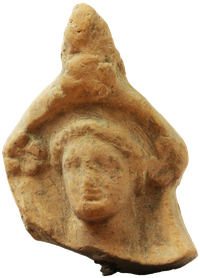Youth symposiast with wreath and bandage
 |
Youth symposiast with wreath and bandage, Inv. T I-30 Front side made of used mould. Back concave, not finished, fleetingly smoothed. Sintered. Traces of vigorous cleaning. Light yellow-brown (7.5 YR 7/5-7/6) clay with single fine inclusions. Remains of light engobe on the wreath and palmette, no traces of painting. Provenance: Unknown. State of preservation: Head with jewellery, broken at an angle in the area of the neck. Dull impression from used mould. Dimensions: H: 9,2 cm; W: 6,6 cm; D: 3,0 cm References: W. Wamser-Krasznai, Studien zu den Typen der Tarentiner Symposiasten (Diss. Justus- Liebig- Universität Gießen 2003) URL: http://geb.uni-giessen.de/geb/volltexte/2003/1184, 100 f. 126. 137. 175 fig. 55.; W.Wamser-Krasznai, Für Götter gelagert (Budapest 2013), 93-96. |
Description: A broad bandage and a thick wreath crowned by a palmette with three five-petalled rosettes adorn the beardless head. Below the rosettes on the sides, bandages unfold, swinging slightly forward and widening downwards. The hair is coiffed upwards from the forehead. Above the right temple, one recognises a raised hair loop and a 'ring curl'.
The rounded top of the head is followed by a lower face, which tapers moderately downwards and ends in a protruding chin. This is set off from the full mouth by a transverse furrow. Above the eyes, which lie deep in their sockets, brow arches are indicated.
The head is turned slightly to the right and is designed to be viewed from the front. While the shortened right cheek leads quickly into the depths, the broader left cheek leads gently backwards.
Commentary: The youthful symposiast represents a type with a protruding, vertically rising headdress and short, asymmetrically coiffed hair that enjoyed great popularity in Taranto as well as in Herakleia and Metapont[1]. The statuette probably held a kantharos in his left hand and wore a cloak wrapped tightly around his left arm[2]. Together with the kline, the statuette will have reached a total height of 20-22 cm.
The posture of the head, downward tending outer corners of the eyes, the flowing transition from the lower eyelid to the cheek area and the full lower lip are stylistic criteria of the first half and middle of the 4th century BC.[3] In addition, there is the two-dimensional execution as a relief with an open back, which also applies to groups[4]. The comparison with artistic products made of other materials leads to a limestone relief from a small Taranto tomb from the early 4th century BC[5], especially with regard to the reproduction of the head inv.-no. T I-30 in three-quarter view.
Determination: Mid 4th century BC or shortly after, from Taranto (Metapont, Herakleia/Lucania).
 |
 |
 |
|---|
[1] B. Neutsch, Archäologische Forschungen in Lukanien II. Herakleiastudien, RM Ergh. 11 (Heidelberg 1967) 171 pl. 32, 1; W. Wamser-Krasznai, Studien zu den Typen der Tarentiner Symposiasten (Diss. Justus- Liebig- Universität Gießen 2003) URL: http://geb.uni-giessen.de/geb/volltexte/2003/1184, 114. 168, fig. 54; D. Adamesteanu – D. Mertens – F. D‘ Andria, Metaponto I, NSc 29 Suppl. 1975 (Rom 1980) 200 f. fig. 210 d; M. G. Liseno, Metaponto. Il deposito votivo favale (Rom 2004) 61 pl. 26 f.
[2] S. Mollard-Besques, Catalogue raisonné des figurines et reliefs en terre-cuite grecs, étrusques et romains. Musée national du Louvre (Paris 1954) 130 no. C 312 pl. 92.
[3] U. Hübinger – M. Menninger, Terrakotten der Westgriechen im Akademischen Kunstmuseum der Universität Bonn (Rahden/Westf. 2007) 147 no. 75; p. 151 no. 79.
[4] E. de Iuliis, Taranto. Città della Magna Grecia (Bari 2000) 93.
[5] E. Langlotz, Die Kunst der Westgriechen (München 1963) 90 pl. 136 b.
